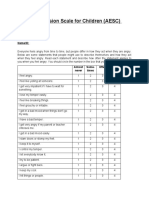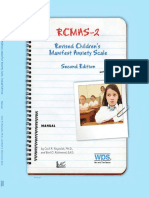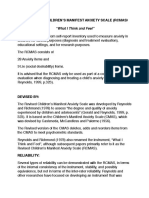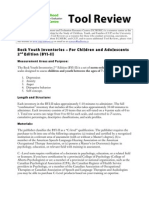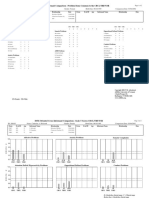100%(8)100% found this document useful (8 votes)
8K viewsRevised Childrens Manifest Anxiety Scale
Revised Childrens Manifest Anxiety Scale
Uploaded by
Anita RosalinaThis document summarizes the Revised Children's Manifest Anxiety Scale (RCMAS), a psychological assessment tool used to measure anxiety in children and adolescents. The RCMAS is a 49-item yes-or-no self-report questionnaire where children rate statements related to anxiety symptoms. It provides a Total Anxiety score as well as scores on three subscales: Physiological Anxiety, Worry/Oversensitivity, and Social Concerns/Concentration. High scores can indicate clinically significant anxiety. The RCMAS takes 10-15 minutes to complete and is suitable for children aged 6-19 years. It is a widely used and valid measure of childhood anxiety.
Copyright:
© All Rights Reserved
Available Formats
Download as DOC, PDF, TXT or read online from Scribd
Revised Childrens Manifest Anxiety Scale
Revised Childrens Manifest Anxiety Scale
Uploaded by
Anita Rosalina100%(8)100% found this document useful (8 votes)
8K views3 pagesThis document summarizes the Revised Children's Manifest Anxiety Scale (RCMAS), a psychological assessment tool used to measure anxiety in children and adolescents. The RCMAS is a 49-item yes-or-no self-report questionnaire where children rate statements related to anxiety symptoms. It provides a Total Anxiety score as well as scores on three subscales: Physiological Anxiety, Worry/Oversensitivity, and Social Concerns/Concentration. High scores can indicate clinically significant anxiety. The RCMAS takes 10-15 minutes to complete and is suitable for children aged 6-19 years. It is a widely used and valid measure of childhood anxiety.
Original Description:
revised childrens manifest anxiety scale
Original Title
revised childrens manifest anxiety scale
Copyright
© © All Rights Reserved
Available Formats
DOC, PDF, TXT or read online from Scribd
Share this document
Did you find this document useful?
Is this content inappropriate?
This document summarizes the Revised Children's Manifest Anxiety Scale (RCMAS), a psychological assessment tool used to measure anxiety in children and adolescents. The RCMAS is a 49-item yes-or-no self-report questionnaire where children rate statements related to anxiety symptoms. It provides a Total Anxiety score as well as scores on three subscales: Physiological Anxiety, Worry/Oversensitivity, and Social Concerns/Concentration. High scores can indicate clinically significant anxiety. The RCMAS takes 10-15 minutes to complete and is suitable for children aged 6-19 years. It is a widely used and valid measure of childhood anxiety.
Copyright:
© All Rights Reserved
Available Formats
Download as DOC, PDF, TXT or read online from Scribd
Download as doc, pdf, or txt
100%(8)100% found this document useful (8 votes)
8K views3 pagesRevised Childrens Manifest Anxiety Scale
Revised Childrens Manifest Anxiety Scale
Uploaded by
Anita RosalinaThis document summarizes the Revised Children's Manifest Anxiety Scale (RCMAS), a psychological assessment tool used to measure anxiety in children and adolescents. The RCMAS is a 49-item yes-or-no self-report questionnaire where children rate statements related to anxiety symptoms. It provides a Total Anxiety score as well as scores on three subscales: Physiological Anxiety, Worry/Oversensitivity, and Social Concerns/Concentration. High scores can indicate clinically significant anxiety. The RCMAS takes 10-15 minutes to complete and is suitable for children aged 6-19 years. It is a widely used and valid measure of childhood anxiety.
Copyright:
© All Rights Reserved
Available Formats
Download as DOC, PDF, TXT or read online from Scribd
Download as doc, pdf, or txt
You are on page 1of 3
At a glance
Powered by AI
The document discusses the Revised Children's Manifest Anxiety Scale (RCMAS), which is a psychological assessment used to measure anxiety in children and adolescents.
The RCMAS scale is used to measure 'the degree and quality of anxiety experienced by children and adolescents'. It assesses overall anxiety as well as three subscales - Physiological Anxiety, Worry/Oversensitivity, and Social Concerns/Concentration.
The RCMAS is suitable for individual or group administration to children ages 6-19. It is best read aloud to younger children. Scores are interpreted based on norms and high overall scores or scores on subscales can indicate clinical levels of anxiety.
The Revised Childrens Manifest Anxiety Scale (RCMAS)
What I Think and Feel
Read each question carefully. Put a circle around the word YES if you think it is true
about you. Put a circle around the word NO if you think it is not true about you.
1. I have trouble makin u! my mind. " Yes No
#. I et nervous when thins do not o the riht way for me. "$ Yes No
%. Others seem to do thins easier than I can. Yes No
&. I like everyone I know. Yes No
'. Often I have trouble ettin my breath. # Yes No
(. I worry a lot of the time. "" Yes No
). I am afraid of a lot of thins. #" Yes No
*. I am always kind. Yes No
+. I et mad easily. % Yes No
"$. I worry about what my !arents will say to me. "# Yes No
"". I feel that others do not like the way I do thins. ## Yes No
"#. I always have ood manners. Yes No
"%. It is hard for me to et to slee! at niht. & Yes No
"&. I worry about what other !eo!le think about me. "% Yes No
"'. I feel alone even when there are !eo!le with me. Yes No
"(. I am always ood. Yes No
"). Often I feel sick in the stomach. ' Yes No
"*. ,y feelins et hurt easily. Yes No
"+. ,y hands feel sweaty. #& Yes No
#$. I am always nice to everyone. Yes No
#". I am tired a lot. ( Yes No
##. I worry about what is oin to ha!!en. "' Yes No
#%. Other children are ha!!ier than I am. #' Yes No
#&. I tell the truth every sinle time. Yes No
#'. I have bad dreams. ) Yes No
Please turn the page
#(. ,y feelins et hurt easily when I am fussed at. Yes No
#). I feel someone will tell me I do thins the wron way. #( Yes No
#*. I never et anry. Yes No
#+. I wake u! scared some of the time. * Yes No
%$. I worry when I o to bed at niht. ") Yes No
%". It is hard for me to kee! my mind on my schoolwork. #) Yes No
%#. I never say thins that I shouldn-t. Yes No
%%. I wrile in my seat a lot. Yes No
%&. I am nervous. "* Yes No
%'. . lot of !eo!le are aainst me. #* Yes No
%(. I never lie. Yes No
%). I often worry about somethin bad ha!!enin to me. "+ Yes No
/evelo!ed by Reynolds and Richmond 0"+)*1 to assess 2the deree and quality of an3iety
e3!erienced by children and adolescents4 05erald and Reynolds6 "+++6 !. %#%1. It is based on
the 7hildren-s ,anifest .n3iety Scale 07,.S16 which was devised by 7asteneda6
,c7andless and Palermo 0"+'(1.
Administration:
8he R7,.S is suitable for individual or rou! administration6 by clinicians6 researchers or
teachers6 with ( to "+ year old children. 8he scale is best read out to children in 5rades one
and two 0or to children who have an equivalent readin ae1. 5rade three and older children
need to be monitored carefully as they read the items themselves6 with e3!lanations iven for
words that they do not understand.
Reynolds and Richmond 0"+)*1 advocate for the use of the R7,.S with children in 5rades
three to twelve6 and more tentatively 02!robably satisfactory46 !. #)+16 for 5rades one and two6
or with children functionin intellectually in that lower rane.
7aution is recommended for the youner children because of the relatively hiher 9ie Scale
scores 0Reynolds and Richmond6 "+)*1. Reynolds6 :radley and Steele 0"+*$1 found that the
youner ae rou! understand and res!ond reliably when the items are read to them.
Scoring Method and Interpretations of Reslts:
Each item is iven a score of " for a 2yes4 res!onse6 yieldin a 8otal .n3iety score 0.g1. 8hree
em!irically derived .n3iety Subscales scores 0Physioloical .n3iety6 ;orry<Oversensitivity6
and Social 7oncerns<7oncentration1 and 9ie Scale scores can be calculated. 8he 9ie scale is
best thouht of as a social desirability scale as it does not directly and conclusively detect
2lyin4.
Stallard6 =elleman6 9ansford and :aldwin 0#$$"1 recommend that an overall cut>off !oint of
"+ out of #* be used to identify children e3!eriencin clinically sinificant levels of an3iety
0!.#$$1.
Reynolds and Richmond 0"+)*1 suest that scores within one standard deviation of the
mean6 at the a!!ro!riate rade level6 be used to indicate scorin within the normal rane of
variability 0see below for norms of means and standard deviations or sources for norms1.
Scores fallin at least one standard deviation from the mean 08 ($1 are thouht to be of
clinical interest. ?owever6 8>scores above )$ should be inter!reted with caution. 8he child-s
res!onse !attern should be e3amined with res!ect to a !roblematic !attern of endorsement or
readin difficulties.
?ih scores on the sub>scales can re!resent different as!ects of an3iety6 which can be used
to develo! hy!otheses about the oriin and nature of a child-s an3iety.
0"1 ?ih scores on the Physiological Factor 0items "6 '6 +6 "%6 ")6 "+6 #"6 #'6 #+6 %%1 can
indicate !hysioloical sins of an3iety 0e sweaty hands6 stomach aches1.
0#1 ?ih scores on the Worry/Oversensitivity Factor 0items #6 (6 )6 "$6 "&6 "*6 ##6 #(6 %$6
%&6 %)1 would suest that the child internalises their e3!eriences of an3iety and that
he or she may feel overwhelmed and withdraw.
0%1 ?ih scores on the Concentration Anxiety Factor 0items %6 ""6 "'6 #%6 #)6 %"6 %'1
would suest that the child is likely to feel that he or she is unable to meet the
e3!ectations of other im!ortant !eo!le6 inadequate and unable to concentrate on
tasks.
Source@ Swinburne Aniversity6 7entre for Neuro!sycholoy6
htt!@<<www.swin.edu.au<victims<resources<assessment<affect<rcmas.html .ccessed@ ,ay #$$)
You might also like
- Beck Youth InventoryDocument2 pagesBeck Youth InventoryHina Abbas Khan35% (34)
- Parent Child Relationship Inventory PCRIDocument3 pagesParent Child Relationship Inventory PCRIselseptiana67% (3)
- Beck Youth Inventories™ - Second Edition (BYI™-II)Document2 pagesBeck Youth Inventories™ - Second Edition (BYI™-II)Sana Khan50% (4)
- Rcmas 2Document1 pageRcmas 2api-50719228950% (4)
- Anger Expression Scale For Children (AESC)Document2 pagesAnger Expression Scale For Children (AESC)AlexandraSabou100% (8)
- Beck Youth Inventories - For Children andDocument12 pagesBeck Youth Inventories - For Children andNarmin Abida36% (11)
- DSM-IV ADHD Symptom Checklist-Child and Adolescent Version # 6177Document1 pageDSM-IV ADHD Symptom Checklist-Child and Adolescent Version # 6177Chris100% (2)
- The Revised Children'S Manifest Anxiety Scale (Rcmas) : "What I Think and Feel"Document3 pagesThe Revised Children'S Manifest Anxiety Scale (Rcmas) : "What I Think and Feel"Rizal Saeful Drajat100% (1)
- Rcmas-2 Manual Chapter 1Document4 pagesRcmas-2 Manual Chapter 1Oyiq Yarsi0% (3)
- Rcmas ScoringDocument6 pagesRcmas ScoringRizal Saeful Drajat50% (6)
- Child Depression Inventory Cdi InterpretationDocument2 pagesChild Depression Inventory Cdi InterpretationGerlinde M Schmidt75% (8)
- Manual PDFDocument159 pagesManual PDFDoniLeite50% (4)
- PArenting Stress ScaleDocument4 pagesPArenting Stress Scaleandradaoltean33% (3)
- Appendix 1 - ADHD Rating ScaleDocument2 pagesAppendix 1 - ADHD Rating Scalepunk_rock_sista295675% (4)
- Eyberg Child Behavior InventoryDocument15 pagesEyberg Child Behavior InventoryEspíritu Ciudadano33% (3)
- Summary of The Explosive ChildDocument10 pagesSummary of The Explosive ChildbabbledingNo ratings yet
- Parent Child Relationship InventoryDocument33 pagesParent Child Relationship InventorySteve Schreiner100% (2)
- Children S Depression InventoryDocument1 pageChildren S Depression Inventoryapi-326282879No ratings yet
- Family Environment ScaleDocument2 pagesFamily Environment ScalelorenzomansanadesiiiNo ratings yet
- Anxiety Scale - ChildDocument2 pagesAnxiety Scale - Childbrian@coombsmd.com90% (21)
- Adolescent Symptom Inventory-4 Parent Checklis - Anp - Ages12up09 - ParentDocument6 pagesAdolescent Symptom Inventory-4 Parent Checklis - Anp - Ages12up09 - ParentEspíritu CiudadanoNo ratings yet
- Beck Youth Inventoiry: Property BYIDocument2 pagesBeck Youth Inventoiry: Property BYIanaq7033% (3)
- BYI II Tool ReviewDocument4 pagesBYI II Tool ReviewAhmed Al-Far100% (1)
- CDI 2 Self-Report Assessment Report - SAMPLEDocument7 pagesCDI 2 Self-Report Assessment Report - SAMPLEJulianaTeixeira0% (1)
- Adhd Rating TeacherDocument2 pagesAdhd Rating TeacherRicardoDG100% (1)
- SDQ English (UK) 4-17scoringDocument3 pagesSDQ English (UK) 4-17scoringprithiksNo ratings yet
- Kanzen Master N3 ReadingDocument1 pageKanzen Master N3 ReadingVirgil Caballero33% (18)
- BRIEF2 Self PiC Interpretive Sample ReportDocument45 pagesBRIEF2 Self PiC Interpretive Sample Reportirina100% (2)
- Depression Scale - ChildDocument2 pagesDepression Scale - Childbrian@coombsmd.com100% (8)
- Cdi ManualDocument68 pagesCdi ManualJosue CuzcanoNo ratings yet
- AQ ChildDocument3 pagesAQ ChildClaudia González Miranda100% (1)
- Parenting Stress IndexDocument3 pagesParenting Stress IndexArif Rohman MansurNo ratings yet
- Scoring Instructions For The Beck Inventories 1Document2 pagesScoring Instructions For The Beck Inventories 1Philip fred100% (5)
- CHILD-parent Relationship ScaleDocument1 pageCHILD-parent Relationship ScaleDyane Juntura100% (8)
- Importance of Media LiteracyDocument1 pageImportance of Media LiteracyRezel FuntilarNo ratings yet
- Cdi2 Handout - Angela Jenn-1Document3 pagesCdi2 Handout - Angela Jenn-1api-206142283No ratings yet
- Diagnostic Parent Rating Scale 1Document3 pagesDiagnostic Parent Rating Scale 1Yet Barreda Basbas100% (2)
- CBRS-Self-Report Assessment ReportDocument24 pagesCBRS-Self-Report Assessment ReportRafael Sanchez0% (3)
- Child's Name: Birthdate - / - / - / Age: School Grade: Parent's Name: Today's Date - / - / - / GenderDocument1 pageChild's Name: Birthdate - / - / - / Age: School Grade: Parent's Name: Today's Date - / - / - / GenderStefania PazNo ratings yet
- Conners Rating ScaleDocument6 pagesConners Rating ScaleNeeraj Mishra100% (3)
- RcmasDocument9 pagesRcmasapi-507192289100% (1)
- CBCL DSM PDFDocument2 pagesCBCL DSM PDFArmando CasillasNo ratings yet
- Conners Teacher Questionaire: Dr. Ananthi Rathinam Dr. Sheila Ramos-Martinez Larah Lucero, PA-CDocument2 pagesConners Teacher Questionaire: Dr. Ananthi Rathinam Dr. Sheila Ramos-Martinez Larah Lucero, PA-CKevin P'ng100% (1)
- Kutcher Depression Scale KADS-11Document3 pagesKutcher Depression Scale KADS-11sunnyNo ratings yet
- Conners 3 Teacher Short - 104024 - 240207 - 113408Document7 pagesConners 3 Teacher Short - 104024 - 240207 - 113408AndreaLopez100% (1)
- Conners IDocument12 pagesConners IThiagoSoaresNo ratings yet
- CAPA - Parent Child Relationship ScaleDocument9 pagesCAPA - Parent Child Relationship ScaleAJNo ratings yet
- Depression Self-Rating Scale For ChildrenDocument4 pagesDepression Self-Rating Scale For ChildrenJasmin Fuentes PaganNo ratings yet
- Instructions: Below Are A Number of Common Problems That Children Have in School. Please Rate Each Item According ToDocument1 pageInstructions: Below Are A Number of Common Problems That Children Have in School. Please Rate Each Item According ToKarina Espina Figueroa100% (1)
- First Grade Math TipsDocument2 pagesFirst Grade Math Tipsapi-240485396No ratings yet
- Revised Childrens Manifest Anxiety ScaleDocument3 pagesRevised Childrens Manifest Anxiety Scalehgs69nb8tbNo ratings yet
- EP3 Lily Week10 Term2Document1 pageEP3 Lily Week10 Term2SitapatrNo ratings yet
- Topic 1 Physical AppearanceDocument14 pagesTopic 1 Physical AppearanceJuan BurgayaNo ratings yet
- CompetenciesDocument9 pagesCompetenciesapi-242440260No ratings yet
- Sample - Nursery Assistant - Interview QuestionsDocument5 pagesSample - Nursery Assistant - Interview QuestionsLorraine BautistaNo ratings yet
- Case StudiesDocument35 pagesCase StudiesemofreeNo ratings yet
- Transactional AnalysisDocument5 pagesTransactional AnalysisJennifer DixonNo ratings yet
- Darren 3Document8 pagesDarren 3api-511517852No ratings yet
- Behavior and AttitudesDocument14 pagesBehavior and AttitudesIldiko SzNo ratings yet
- IELTS General Questions and Possible AnswersDocument24 pagesIELTS General Questions and Possible AnswersTassaduq KhokharNo ratings yet
- Tthudhtad 136Document6 pagesTthudhtad 136Huyen NguyenNo ratings yet
- Basic Psychological Needs ScaleDocument6 pagesBasic Psychological Needs ScalebpregerNo ratings yet
- DevOpd 1693819378Document36 pagesDevOpd 1693819378moscosoandresNo ratings yet
- Task Based Learning and Competency BasedDocument17 pagesTask Based Learning and Competency Basedmeymirah100% (1)
- Cambridge O Level: Biology 5090/11 May/June 2021Document3 pagesCambridge O Level: Biology 5090/11 May/June 2021uzumakiandhyugaclanNo ratings yet
- Time Table For PT-1-1Document1 pageTime Table For PT-1-1My HomeNo ratings yet
- Chem Ig QuestionsDocument4 pagesChem Ig QuestionsRayan BelalNo ratings yet
- Phrasal Verbs ExerciseDocument4 pagesPhrasal Verbs ExerciseSimona Elena MosinaNo ratings yet
- SocPsy Textbook NotesDocument6 pagesSocPsy Textbook NotesDannielle CabangNo ratings yet
- Barriers of CommunicationDocument2 pagesBarriers of CommunicationRaymond ManalangNo ratings yet
- Detailed Lesson Plan For Grade 10Document7 pagesDetailed Lesson Plan For Grade 10Jamaica Rose BalbinNo ratings yet
- Payment of Fees Old Students 2024 To 2025Document3 pagesPayment of Fees Old Students 2024 To 2025chinazapaschaliaNo ratings yet
- Protocol and Public RelationsDocument8 pagesProtocol and Public RelationsScribdTranslationsNo ratings yet
- English Prepositions PDFDocument4 pagesEnglish Prepositions PDFmunish0875No ratings yet
- Fresh Off The Boat-S01E02Document15 pagesFresh Off The Boat-S01E02yu peiNo ratings yet
- E N D O R S E M E N T: School Improvement Plan School Year 2016-2019Document3 pagesE N D O R S E M E N T: School Improvement Plan School Year 2016-2019Mirasol BaringNo ratings yet
- G Giri Babu SirDocument1 pageG Giri Babu SirvvitieeesbNo ratings yet
- Monografía CoursesproDocument96 pagesMonografía Coursesprosandra pezetNo ratings yet
- LANGUAGE CENTER UNC CAJAMARCA Unit 5 Quiz For MondayDocument4 pagesLANGUAGE CENTER UNC CAJAMARCA Unit 5 Quiz For MondaysergioNo ratings yet
- LESSON PLAN YR 6 WEEK 21 at 2019Document5 pagesLESSON PLAN YR 6 WEEK 21 at 2019Sharmila RajNo ratings yet
- Inquiry 94-1: SNT-TC-1A, 1984 Edition, ParagraphDocument2 pagesInquiry 94-1: SNT-TC-1A, 1984 Edition, Paragraphஅன்புடன் அஸ்வின்No ratings yet
- Feedback Sheet Alex RemmingtonDocument2 pagesFeedback Sheet Alex Remmingtonmediastudies1No ratings yet
- Exemple de Dissertation Explicative BaudelaireDocument5 pagesExemple de Dissertation Explicative BaudelairePaperWritingServicesOnlineUK100% (1)
- Powerpoint Slides Prepared by Leonard R. Mendola, PHD Touro CollegeDocument69 pagesPowerpoint Slides Prepared by Leonard R. Mendola, PHD Touro CollegeLarissa SuárezNo ratings yet
- Software Testing AssignmentDocument4 pagesSoftware Testing AssignmentGuna Ram0% (1)
- Applications LETTERDocument5 pagesApplications LETTERmichael ricafortNo ratings yet
- Adaptive Coping Strategies (AKU Internal) : ReferenceDocument3 pagesAdaptive Coping Strategies (AKU Internal) : ReferenceNiki AmaliaNo ratings yet
- Pidsr2011annual ReportDocument55 pagesPidsr2011annual ReportApril GuiangNo ratings yet
- EIM TM! Session PlanDocument11 pagesEIM TM! Session PlanTimothy John Natal Mandia100% (5)
- EEE VCE R15 B.Tech - PDFDocument261 pagesEEE VCE R15 B.Tech - PDFgeethaNo ratings yet




